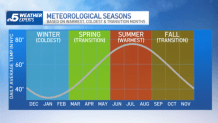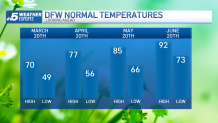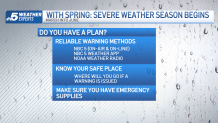
ASTRONOMICAL SPRING
Astronomical spring begins on the vernal equinox, which is the point in the Earth’s orbit when the Sun is directly over the equator on its journey higher in the northern hemisphere sky. Each year, the vernal equinox falls somewhere between March 19th and March 21st. This year, it falls on March 20th – at 4:01 a.m. CT.
Watch NBC 5 free wherever you are

Summer, fall and winter begin at very specific points along the Earth’s orbit:
Get top local stories in DFW delivered to you every morning with NBC DFW's News Headlines newsletter.
- Beginning of summer: The summer solstice, anywhere from June 20th to June 22nd each year. This is when the Sun is positioned directly over the Tropic of Cancer in the northern hemisphere. It marks the highest position of the Sun overhead for those of us in the United States, and it also marks the day with the greatest amount of daylight. This year, the summer solstice is on June 21st at 9:42 p.m. CT.
- Beginning of fall: Fall begins either on Sept. 22nd or Sept. 23rd, depending on when the autumnal equinox happens in a particular year. The autumnal equinox is the point at which the Sun is directly over the equator, like at the beginning of spring, but in this case, the sun is progressively getting lower in the northern hemisphere sky and colder temperatures are on the way.
- Beginning of winter: The winter solstice marks the start of winter. It happens each year sometime between Dec. 20th and Dec. 23rd. This year, it will happen at 9:03 a.m. CT on Dec. 21st. It marks the point when the Sun is directly over the Tropic of Capricorn in the southern hemisphere. It is the time when the Sun is at its lowest point in the northern hemisphere’s sky, and it marks the day with the least amount of daylight in the year. It also signals the coldest stretch of weather for us in the United States.
METEOROLOGICAL SPRING
Meteorologists define spring, and seasons in general, in equal three-month chunks that mark the warmest, coldest, and transitional stretches of weather for a region. It is a more consistent method of defining the seasons and helps with record-keeping.

Here is how the seasons are divided meteorologically:
- Winter: Dec. 1st to Feb. 28th – the coldest three months of the year.
- Spring: March 1st to May 31st – The steady three-month transition from cold to warm.
- Summer: June 1st to Aug. 31st – The warmest three months of the year.
- Fall: The steady, three-month transition from warm to cold.
The definitions of meteorological seasons are simpler and more consistent, and they define the calendar year more logically based on temperature. Scientifically, meteorological seasons are useful for comparing weather year-to-year. Because the timing is the same each year, any comparisons are apples-to-apples, if you will.
Spring marks a rise in normal temperatures across North Texas.

Increasing temperatures and impending storm systems will also lead to severe weather potential. Spring marks the most active severe weather months across North Texas.


